Siderol Inhibits Proliferation of Glioblastoma Cells and Acts Synergistically with Temozolomide
Abstract
:1. Introduction
2. Materials and Methods
2.1. Cell Lines and Conditions for Treatment
2.2. Viability Assay
2.3. Flow Cytometric Analysis of DNA Cell Cycle
2.4. Wound Healing Assay
2.5. Combination Treatment with Siderol and TMZ
2.6. Statistical Analysis
3. Results
3.1. Viability of GBM Cells after Treatment with Siderol and IC50 Calculation
3.2. Viability of GBM Cells after Treatment with TMZ and IC50 Calculation
3.3. Siderol Induced G0/G1 Cell Cycle Arrest in Both Cell Lines
3.4. Siderol Inhibited Cell Migration in Both Cell Lines
3.5. Siderol and TMZ Have Synergistic Effect in Both Cell Lines
4. Discussion
Author Contributions
Funding
Informed Consent Statement
Conflicts of Interest
Abbreviations
| GBM | Glioblastoma |
| CNS | Central Nervous System |
| TMZ | Temozolomide |
| MTT | 3-(4,5-dimethylthiazol-2-yl)-2,5-diphenyltetrazolium bromide |
| FDA | Food and Drug Administration |
| BBB | Blood–Brain Barrier |
| DMEM | Dulbecco’s Modified Eagle’s Medium |
| DMSO | Dimethyl Sulfoxide |
| PBS | Phosphate-Buffered Saline |
| PI | Propidium Iodide |
| FBS | Fetal Bovine Serum |
| SD | Standard Deviation |
| CI | Combination Index |
| EMA | European Medicines Agency |
References
- Weathers, S.P.; Gilbert, M.R. Advances in treating glioblastoma. F1000Prime Rep. 2014, 6, 46. [Google Scholar] [CrossRef]
- Dorte, S.N.; Poulsen, H.; Lassen, U. Hallmarks of glioblastoma: A systematic review. ESMO Open 2016, 1, e000144. [Google Scholar] [CrossRef]
- Stupp, R.; Mason, W.P.; van den Bent, M.J.; Weller, M.; Fisher, B.; Taphoorn, M.J.B.; Belanger, K.; Brandes, A.A.; Marosi, C.; Bogdahn, U.; et al. Radiotherapy plus concomitant and adjuvant temozolomide for glioblastoma. N. Engl. J. Med. 2005, 352, 987–996. [Google Scholar] [CrossRef] [Green Version]
- Gilbert, M.R.; Wang, M.; Aldape, K.D.; Stupp, R.; Hegi, M.E.; Jaeckle, K.A.; Armstrong, T.S.; Wefel, J.S.; Won, M.; Blumenthal, D.T.; et al. Dose-dense temozolomide for newly diagnosed glioblastoma: A randomized phase III clinical trial. J. Clin. Oncol. 2013, 31, 4085–4091. [Google Scholar] [CrossRef] [Green Version]
- Vengoji, R.; Macha, M.A.; Batra, S.K.; Shonka, N.A. Natural products: A hope for glioblastoma patients. Oncotarget 2018, 9, 22194–22219. [Google Scholar] [CrossRef] [Green Version]
- Levin, V.A.; Ellingson, B.M. Understanding brain penetrance of anticancer drugs. Neuro. Oncol. 2018, 20, 589–596. [Google Scholar] [CrossRef] [Green Version]
- Banks, W.A. Characteristics of compounds that cross the blood-brain barrier. BMC Neurol. 2009, 9 (Suppl. S1), S3. [Google Scholar] [CrossRef] [Green Version]
- Zhai, K.; Siddiqui, M.; Abdellatif, B.; Liskova, A.; Kubatka, P.; Büsselberg, D. Natural Compounds in Glioblastoma Therapy: Preclinical Insights, Mechanistic Pathways, and Outlook. Cancers 2021, 13, 2317. [Google Scholar] [CrossRef]
- Sarikurkcu, C.; Locatelli, M.; Mocan, A.; Zengin, G.; Kirkan, B. Phenolic Profile and Bioactivities of Sideritis perfoliata L.: The Plant, Its Most Active Extract, and Its Broad Biological Properties. Front. Pharmacol. 2020, 10, 1642. [Google Scholar] [CrossRef] [Green Version]
- Axiotis, E.; Petrakis, E.A.; Halabalaki, M.; Mitakou, S. Phytochemical Profile and Biological Activity of Endemic Sideritis sipylea Boiss. in North Aegean Greek Islands. Molecules 2020, 25, 2022. [Google Scholar] [CrossRef]
- Şimşek, E.; Uysal, T. The Effects of the Sideritis ozturkii Extract on the Expression Levels of some Apoptotic Genes. Curr. Perspect. Med. Aromat. Plants (CUPMAP) 2018, 1, 8–12. [Google Scholar]
- González-Burgos, E.; Carretero, M.E.; Gómez-Serranillos, M.P. Sideritis spp.: Uses, chemical composition and pharmacological activities—A review. J. Ethnopharmacol. 2011, 135, 209–225. [Google Scholar] [CrossRef]
- Cavalcanti, M.R.M.; Passos, F.R.S.; Monteiro, B.S.; Gandhi, S.R.; Heimfarth, L.; Lima, B.S.; Nascimento, Y.M.; Duarte, M.C.; Araujo, A.A.; Menezes, I.R.; et al. HPLC-DAD-UV analysis, anti-inflammatory and anti-neuropathic effects of methanolic extract of Sideritis bilgeriana (lamiaceae) by NF-κB, TNF-α, IL-1β and IL-6 involvement. J. Ethnopharmacol. 2021, 265, 113338. [Google Scholar] [CrossRef]
- Żyżelewicz, D.; Kulbat-Warycha, K.; Oracz, J.; Żyżelewicz, K. Polyphenols and Other Bioactive Compounds of Sideritis Plants and Their Potential Biological Activity. Molecules 2020, 25, 3763. [Google Scholar] [CrossRef]
- Oalđe, M.; Kolarević, S.; Živković, J.; Aradski, A.A.; Marić, J.J.; Kolarević, M.K.; Đorđević, J.; Marin, P.D.; Šavikin, K.; Vuković-Gačić, B.; et al. A comprehensive assessment of the chemical composition, antioxidant, genoprotective and antigenotoxic activities of Lamiaceae species using different experimental models in vitro. Food Funct. 2021, 12, 3233–3245. [Google Scholar] [CrossRef]
- Stagos, D.; Portesis, N.; Spanou, C.; Mossialos, D.; Aligiannis, N.; Chaita, E.; Panagoulis, C.; Reri, E.; Skaltsounis, L.; Tsatsakis, A.M.; et al. Correlation of total polyphenolic content with antioxidant and antibacterial activity of 24 extracts from Greek domestic Lamiaceae species. Food Chem. Toxicol. 2012, 50, 4115–4124. [Google Scholar] [CrossRef]
- Ma, R.; Taphoorn, M.J.B.; Plaha, P. Advances in the management of glioblastoma. J. Neurol. Neurosurg. Psychiatry 2021, 92, 1103–1111. [Google Scholar] [CrossRef]
- Liu, S.; Shi, W.; Zhao, Q.; Zheng, Z.; Liu, Z.; Meng, L.; Dong, L.; Jiang, X. Progress and prospect in tumor treating fields treatment of glioblastoma. Biomed. Pharmacother. 2021, 141, 111810. [Google Scholar] [CrossRef]
- Goenka, A.; Tiek, D.; Song, X.; Huang, T.; Hu, B.; Cheng, S.Y. The Many Facets of Therapy Resistance and Tumor Recurrence in Glioblastoma. Cells 2021, 10, 484. [Google Scholar] [CrossRef]
- Uddin, M.S.; Kabir, M.T.; Mamun, A.A.; Sarwar, S.; Nasrin, F.; Bin Emran, T.; Alanazi, I.S.; Rauf, A.; Albadrani, G.M.; Sayed, A.A.; et al. Natural Small Molecules Targeting NF-κB Signaling in Glioblastoma. Front. Pharmacol. 2021, 12, 703761. [Google Scholar] [CrossRef]
- Soukhtanloo, M.; Mohtashami, E.; Maghrouni, A.; Mollazadeh, H.; Mousavi, S.H.; Roshan, M.K.; Tabatabaeizadeh, S.-A.; Hosseini, A.; Vahedi, M.M.; Jalili-Nik, M.; et al. Natural products as promising targets in glioblastoma multiforme: A focus on NF-κB signaling pathway. Pharmacol. Rep. 2020, 72, 285–295. [Google Scholar] [CrossRef]
- Behl, T.; Sharma, A.; Sharma, L.; Sehgal, A.; Singh, S.; Sharma, N.; Zengin, G.; Bungau, S.; Toma, M.; Gitea, D.; et al. Current Perspective on the Natural Compounds and Drug Delivery Techniques in Glioblastoma Multiforme. Cancers 2021, 13, 2765. [Google Scholar] [CrossRef]
- Arcella, A.; Sanchez, M. Natural substances to potentiate canonical glioblastoma chemotherapy. J. Chemother. 2021, 33, 276–287. [Google Scholar] [CrossRef]
- Zoi, V.; Galani, V.; Vartholomatos, E.; Zacharopoulou, N.; Tsoumeleka, E.; Gkizas, G.; Bozios, G.; Tsekeris, P.; Chousidis, I.; Leonardos, I.; et al. Curcumin and Radiotherapy Exert Synergistic Anti-Glioma Effect In Vitro. Biomedicines 2021, 9, 1562. [Google Scholar] [CrossRef]
- Koromili, M.; Kapourani, A.; Koletti, A.; Papandreou, G.; Assimopoulou, A.N.; Lazari, D.; Barmpalexis, P. Preparation and Evaluation of Siderol Amorphous Solid Dispersions: Selection of Suitable Matrix/Carrier. AAPS PharmSciTech 2022, 23, 214. [Google Scholar] [CrossRef]
- Pihan, L.A.; Peter, S.; Vollmer, G.; Meier, B.; Wolfram, E. HPTC Fingerprint Authentication of Selected Sideritis spp. Using a Pharmacognostic Approach. Planta Med. 2021, 87, 1152–1166. [Google Scholar] [CrossRef]
- Romanucci, V.; Di Fabio, G.; D′Alonzo, D.; Guaragna, A.; Scapagnini, G.; Zarrelli, A. Traditional uses, chemical composition and biological activities of Sideritis raeseri Boiss. & Heldr. J. Sci. Food Agric. 2017, 97, 373–383. [Google Scholar] [CrossRef]
- Çelik, T.; Önderci, M.; Pehlivan, M.; Yumrutaş, Ö.; Üçkardeş, F. In vitro scolicidal effects of Sideritis perfoliata extract against Echinococcus granulosus. Int. J. Clin. Pract. 2021, 75, e14498. [Google Scholar] [CrossRef]
- Güvenç, A.; Okada, Y.; Akkol, E.K.; Duman, H.; Okuyama, T.; Çalış, I. Investigations of anti-inflammatory, antinociceptive, antioxidant and aldose reductase inhibitory activities of phenolic compounds from Sideritis brevibracteata. Food Chem. 2010, 118, 686–692. [Google Scholar] [CrossRef]
- Tomou, E.M.; Lytra, K.; Chrysargyris, A.; Christofi, M.-D.; Miltiadous, P.; Corongiu, G.L.; Tziouvelis, M.; Tzortzakis, N.; Skaltsa, H. Polar constituents, biological effects and nutritional value of Sideritis sipylea Boiss. Nat. Prod. Res. 2022, 36, 4200–4204. [Google Scholar] [CrossRef]
- Charami, M.T.; Lazari, D.; Karioti, A.; Skaltsa, H.; Hadjipavlou-Litina, D.; Souleles, C. Antioxidant and antiinflammatory activities of Sideritis perfoliata subsp. perfoliata (Lamiaceae). Phytother. Res. 2008, 22, 450–454. [Google Scholar] [CrossRef] [PubMed]
- Sklirou, A.D.; Angelopoulou, M.T.; Argyropoulou, A.; Chaita, E.; Boka, V.; Cheimonidi, C.; Niforou, K.; Mavrogonatou, E.; Pratsinis, H.; Kalpoutzakis, E.; et al. Phytochemical Study and In Vitro Screening Focusing on the Anti-Aging Features of Various Plants of the Greek Flora. Antioxidants 2021, 10, 1206. [Google Scholar] [CrossRef]
- Tomou, E.-M.; Papaemmanouil, C.D.; Diamantis, D.A.; Kostagianni, A.D.; Chatzopoulou, P.; Mavromoustakos, T.; Tzakos, A.G.; Skaltsa, H. Anti-Ageing Potential of S. euboea Heldr. Phenolics. Molecules 2021, 26, 3151. [Google Scholar] [CrossRef]
- Loğoğlu, E.; Arslan, S.; Oktemer, A.; Sakõyan, I. Biological activities of some natural compounds from Sideritis sipylea Boiss. Phytother. Res. 2006, 20, 294–297. [Google Scholar] [CrossRef]
- Aligiannis, N.; Kalpoutzakis, E.; Chinou, I.B.; Mitakou, S.; Gikas, E.; Tsarbopoulos, A. Composition and antimicrobial activity of the essential oils of five taxa of Sideritis from Greece. J. Agric. Food Chem. 2001, 49, 811–815. [Google Scholar] [CrossRef]
- Şimşek Sezer, E.N.; Uysal, T. Phytochemical Analysis, Antioxidant and Anticancer Potential of Sideritis niveotomentosa: Endemic Wild Species of Turkey. Molecules 2021, 26, 2420. [Google Scholar] [CrossRef]
- Demirelma, H.; Gelinci, E. Determination of the Cytotoxic Effect on Human Colon Cancer and Phenolic Substance Content of the Endemic Species Sideritis Ozturkii Aytaç & Aksoy. Appl. Ecol. Environ. Res. 2019, 17, 7407–7419. [Google Scholar] [CrossRef]
- Porter, A.; Jänicke, R. Emerging roles of caspase-3 in apoptosis. Cell Death Differ. 1999, 6, 99–104. [Google Scholar] [CrossRef]
- Yumrutas, O.; Oztuzcu, S.; Ozturk, N.; Pehlivan, M.; Poyraz, E.; Bozgeyik, I.; ZiyaIÄŸci, Y.; Cevik, M.O.; Aksoy, A.F.; Bagıs, H.; et al. Cell viability, anti-proliferation and antioxidant activities of Sideritis syriaca, Tanacetum argenteum subsp. argenteum and Achillea aleppica subsp. zederbaueri on human breast cancer cell line (MCF-7). J. App. Pharm. Sci. 2015, 5, 001–005. [Google Scholar] [CrossRef] [Green Version]
- Wang, R.; Liu, T.; Chen, J.; Zhang, D. Paradol Induces Cell Cycle Arrest and Apoptosis in Glioblastoma Cells. Nutr. Cancer 2022, 74, 3007–3014. [Google Scholar] [CrossRef]
- Chen, J.; Ouyang, Y.; Cao, L.; Zhu, W.; Zhou, Y.; Zhou, Y.; Zhang, H.; Yang, X.; Mao, L.; Lin, S.; et al. Diazepam inhibits proliferation of human glioblastoma cells through triggering a G0/G1 cell cycle arrest. J. Neurosurg. Anesthesiol. 2013, 25, 285–291. [Google Scholar] [CrossRef]
- Liu, X.; Chen, J.Y.; Chien, Y.; Yang, Y.P.; Chen, M.T.; Lin, L.T. Overview of the molecular mechanisms of migration and invasion in glioblastoma multiforme. J. Chin. Med. Assoc. 2021, 84, 669–677. [Google Scholar] [CrossRef]
- Tomou, E.-M.; Chatziathanasiadou, M.V.; Chatzopoulou, P.; Tzakos, A.G.; Skaltsa, H. NMR-Based Chemical Profiling, Isolation and Evaluation of the Cytotoxic Potential of the Diterpenoid Siderol from Cultivated Sideritis euboea Heldr. Molecules 2020, 25, 2382. [Google Scholar] [CrossRef]
- Lytra, K.; Tomou, E.M.; Chrysargyris, A.; Christofi, M.; Miltiadous, P.; Tzortzakis, N.; Skaltsa, H. Bio-Guided Investigation of Sideritis cypria Methanol Extract Driven by in Vitro Antioxidant and Cytotoxic Assays. Chem. Biodivers. 2021, 18, e2000966. [Google Scholar] [CrossRef]

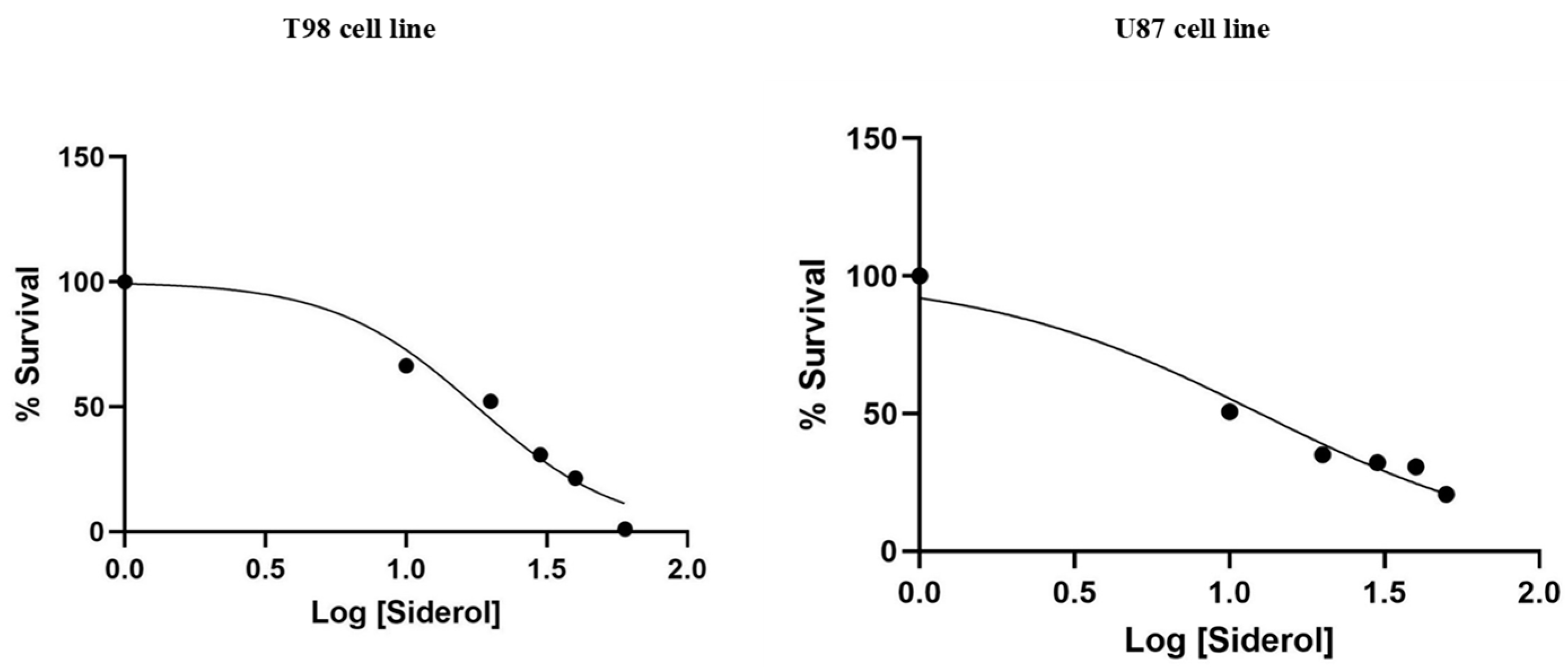
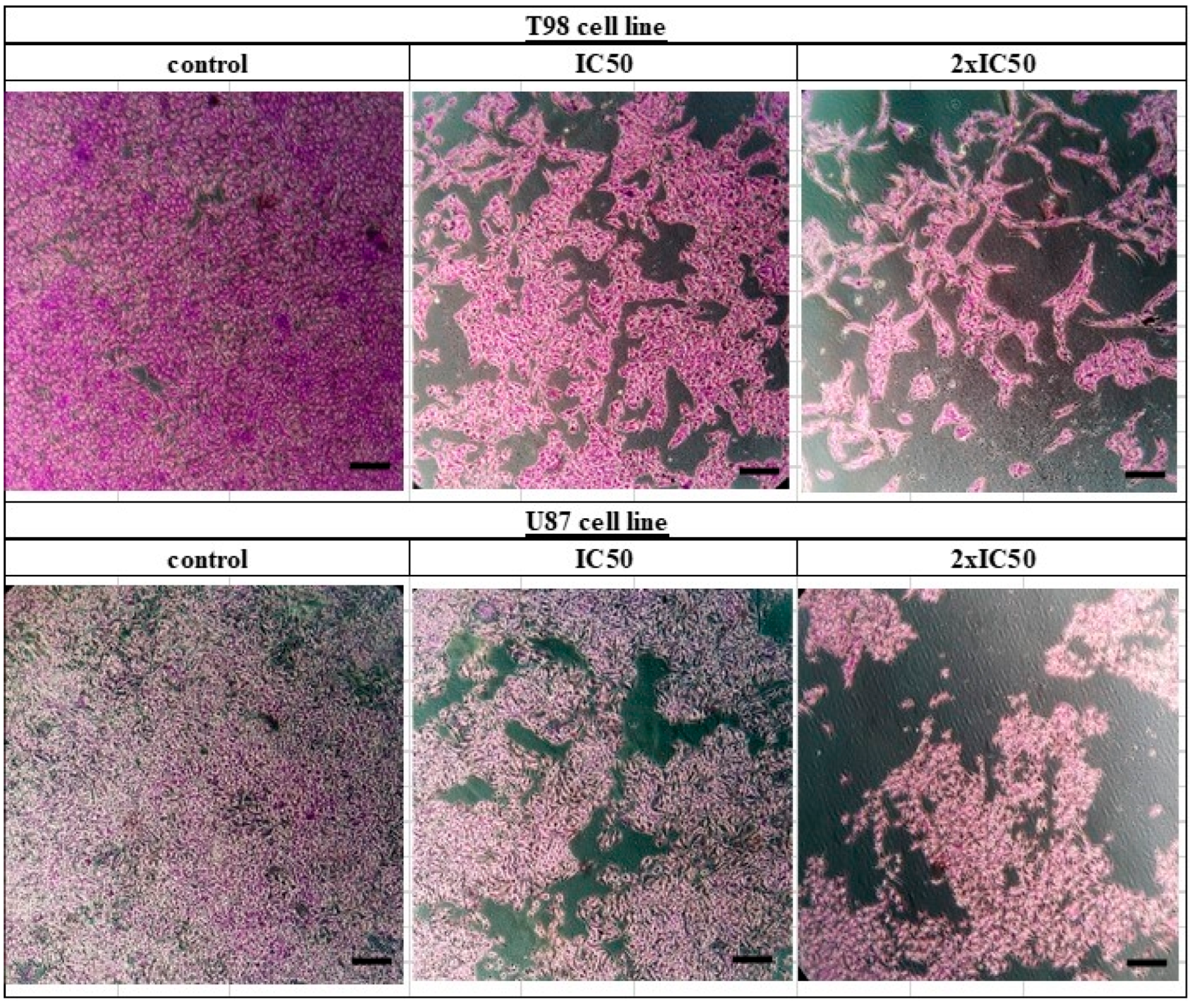





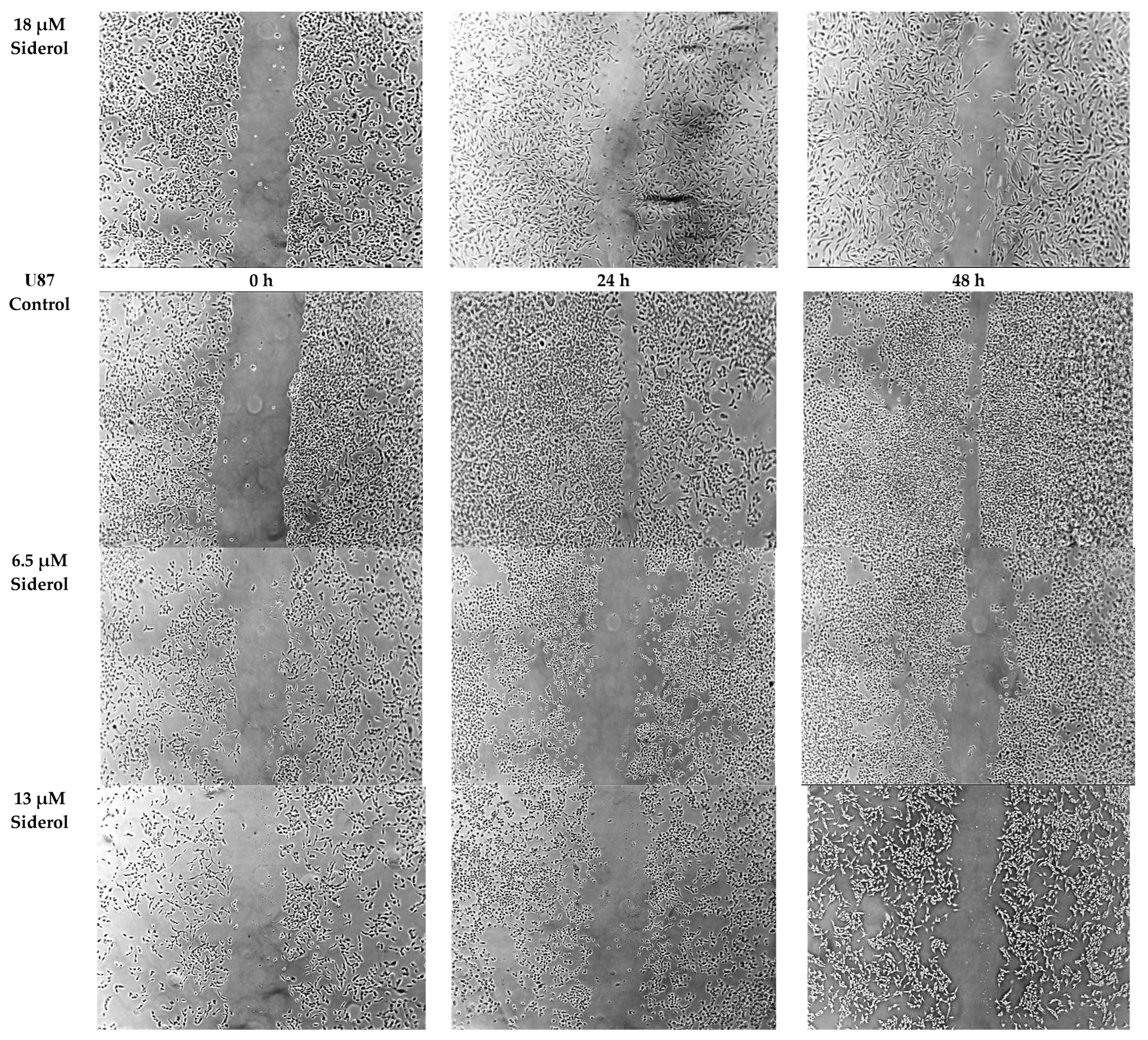
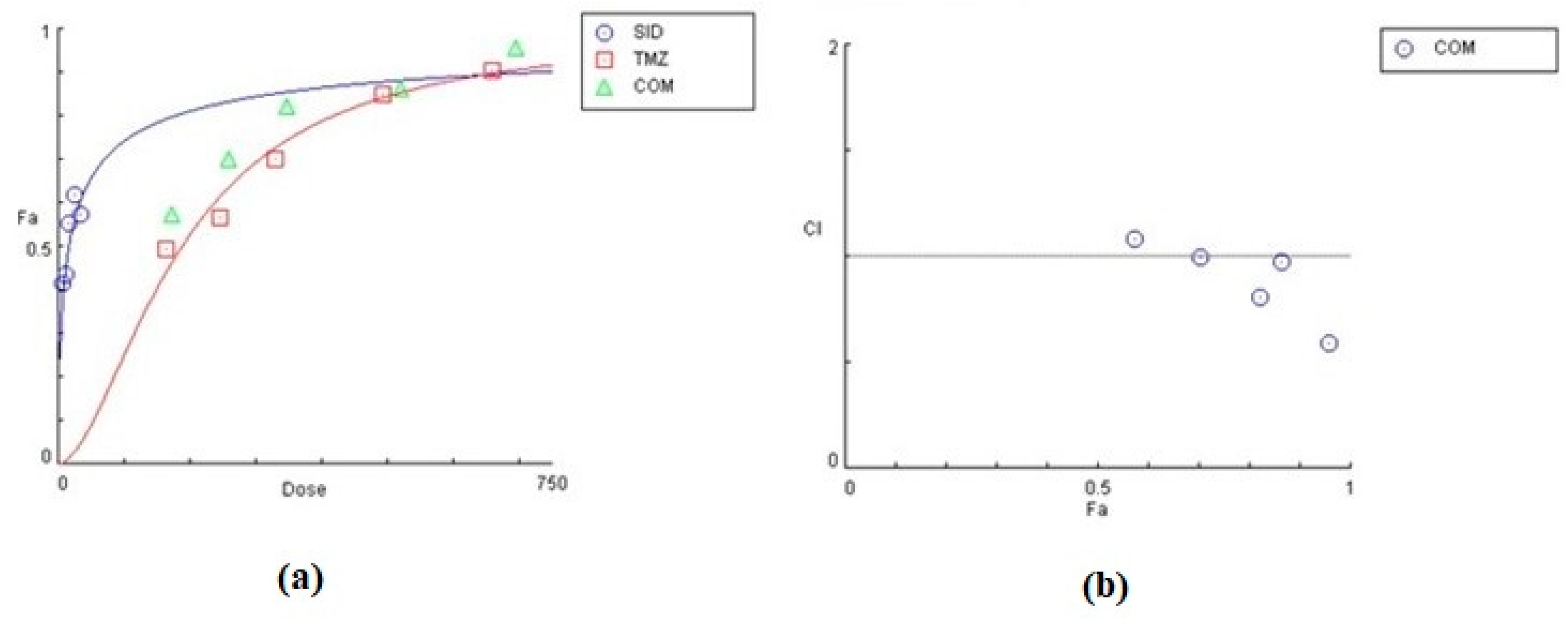
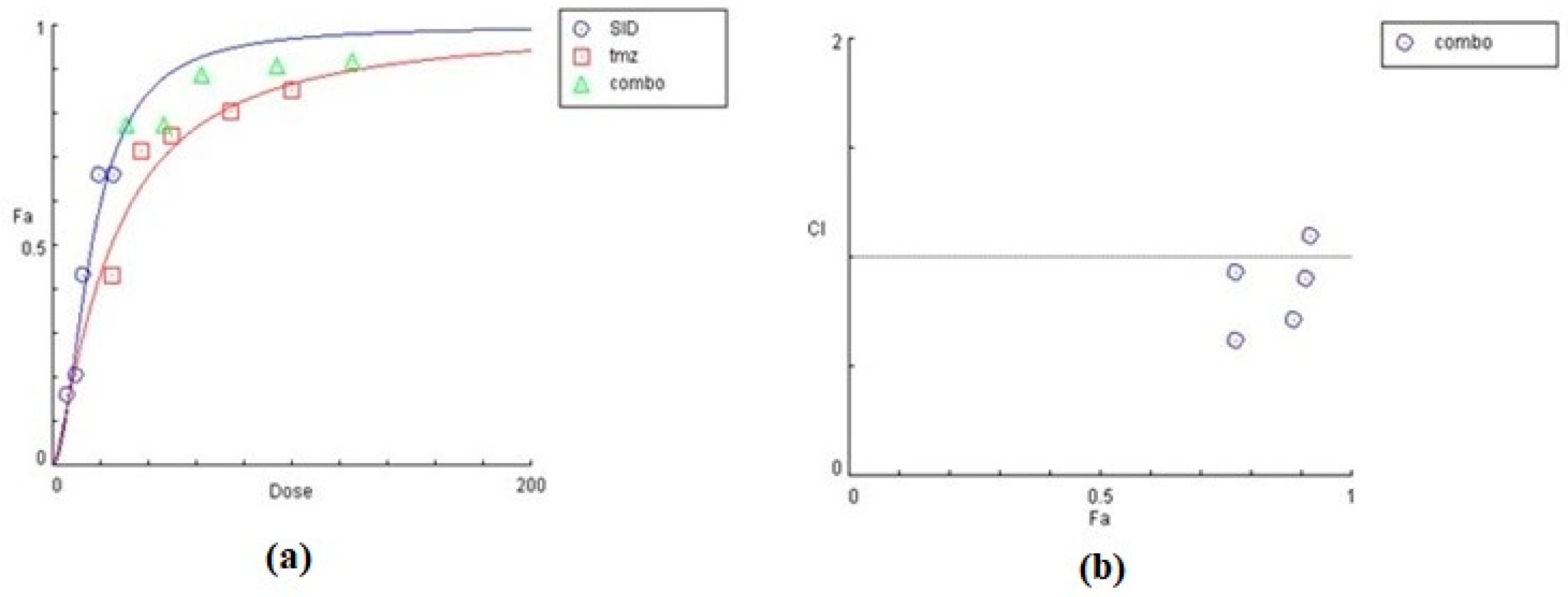
| a | Treatment | SubG₀ (M4) | G₀/G₁ (M1) | S (M2) | G₂/M (M3) |
| Control | 0.26 ± 0.1 | 70.64 ± 1.3 | 16.58 ± 0.8 | 13.19 ± 0.7 | |
| 18 μM Siderol | 1.3 ± 1.2 | 72.5 ± 2.5 | 16.24 ± 0.4 | 10.6 ± 3.1 | |
| 36 μM Siderol | 2.4 ± 0.6 * | 76.37 ± 1.1 * | 15.57 ± 0.4 | 6.86 ± 1.2 * | |
| b | Treatment | SubG₀ (M4) | G₀/G₁ (M1) | S (M2) | G₂/M (M3) |
| Control | 0 ± 0.01 | 55.4 ± 0.5 | 22.7 ± 0.4 | 19.4 ± 0.7 | |
| 13 μM Siderol | 0.23 ± 0.03 * | 65.47 ± 0.59 * | 19.13 ± 0.74 * | 12.97 ± 0.12 * | |
| 26 μM Siderol | 0.3 ± 0.15 * | 66.7 ± 0.5 * | 17.8 ± 0.44 * | 13.5 ± 0.44 * |
| Siderol (μM) | Temozolomide (μM) | Effect | CI | Conclusion |
|---|---|---|---|---|
| 9 | 165 | 0.57 | 1.08150 | Antagonism |
| 13.5 | 247 | 0.70 | 0.99326 | Synergism |
| 18 | 330 | 0.82 | 0.80500 | Synergism |
| 27 | 495 | 0.86 | 0.97489 | Synergism |
| 36 | 660 | 0.96 | 0.58721 | Synergism |
| Siderol (μM) | Temozolomide (μM) | Effect | CI | Conclusion |
|---|---|---|---|---|
| 6.5 | 25 | 0.77 | 0.61869 | Synergism |
| 9.75 | 37.5 | 0.77 | 0.92803 | Synergism |
| 13 | 50 | 0.89 | 0.71018 | Synergism |
| 19.5 | 75 | 0.91 | 0.90397 | Synergism |
| 26 | 100 | 0.92 | 1.0944 | Antagonism |
Publisher’s Note: MDPI stays neutral with regard to jurisdictional claims in published maps and institutional affiliations. |
© 2022 by the authors. Licensee MDPI, Basel, Switzerland. This article is an open access article distributed under the terms and conditions of the Creative Commons Attribution (CC BY) license (https://creativecommons.org/licenses/by/4.0/).
Share and Cite
Giannakopoulou, M.; Dimitriadis, K.; Koromili, M.; Zoi, V.; Vartholomatos, E.; Galani, V.; Kyritsis, A.P.; Alexiou, G.A.; Lazari, D. Siderol Inhibits Proliferation of Glioblastoma Cells and Acts Synergistically with Temozolomide. Biomedicines 2022, 10, 3216. https://doi.org/10.3390/biomedicines10123216
Giannakopoulou M, Dimitriadis K, Koromili M, Zoi V, Vartholomatos E, Galani V, Kyritsis AP, Alexiou GA, Lazari D. Siderol Inhibits Proliferation of Glioblastoma Cells and Acts Synergistically with Temozolomide. Biomedicines. 2022; 10(12):3216. https://doi.org/10.3390/biomedicines10123216
Chicago/Turabian StyleGiannakopoulou, Maria, Kiriakos Dimitriadis, Maria Koromili, Vasiliki Zoi, Evrysthenis Vartholomatos, Vasiliki Galani, Athanassios P. Kyritsis, George A. Alexiou, and Diamanto Lazari. 2022. "Siderol Inhibits Proliferation of Glioblastoma Cells and Acts Synergistically with Temozolomide" Biomedicines 10, no. 12: 3216. https://doi.org/10.3390/biomedicines10123216






